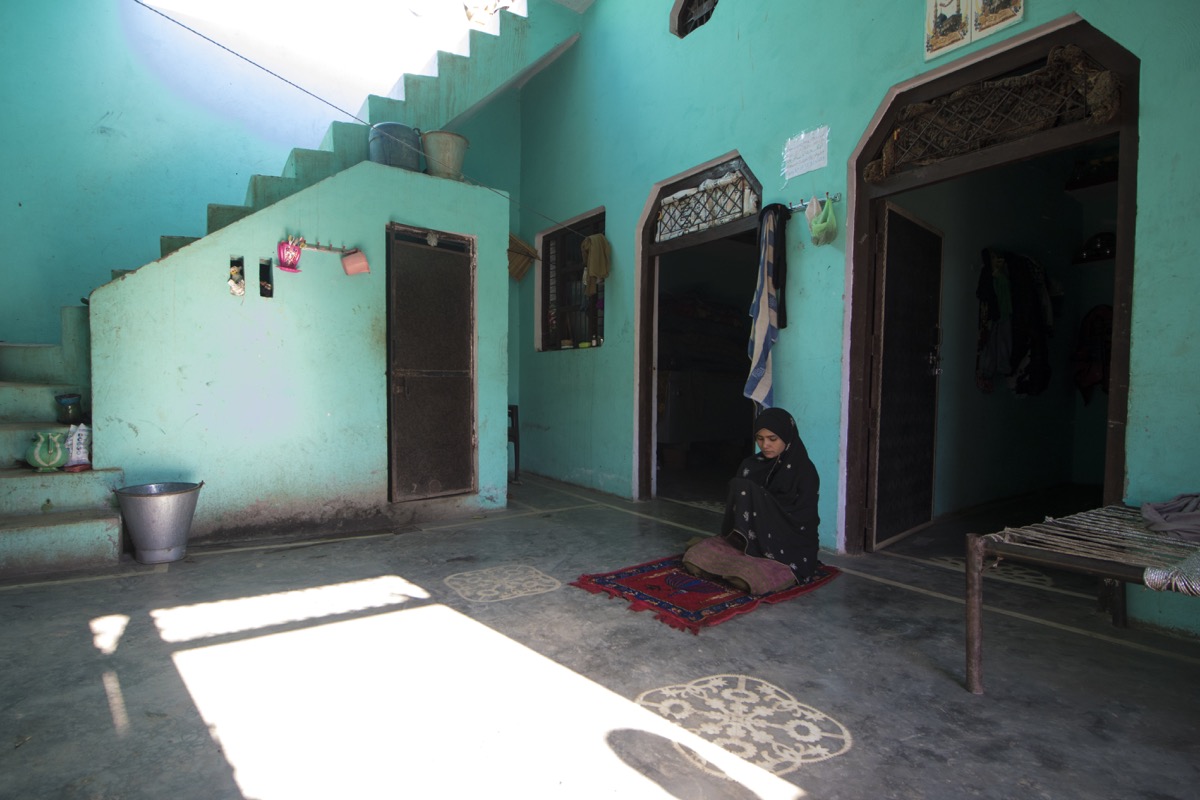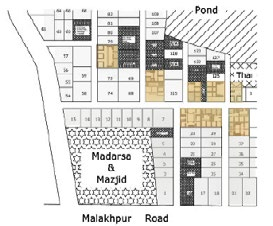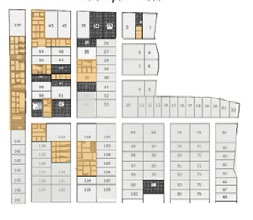Authors: Sandeep Virmani & Tanvi Choudhari
Hunnarshala was invited by an umbrella organisation, Joint Citizen’s Initiative (JCI) formed by Vanagana, Sadbhavna Trust, Janvikas and some independent citizens in response to the communal riots in Muzaffarnagar which displaced thousands of families. Hunnarshala provided technical support and facilitation to people for building houses and infrastructure, while JCI organised the community. They provided relief and helped them integrate into their new villages by organising their new identity papers like Aadhar Card, ration cards, electoral papers etc. They also helped the children with tutorials and exams, psychosocial counselling, admission into new schools, health camps and economic rehabilitation.
The rehabilitation program started in 2014 with the support of Misereor, a Germany based development agency and HT Parekh Foundation. A total of 230 houses were built and improved in three locations; Aryapuri, Kandhla and Bassikalan.
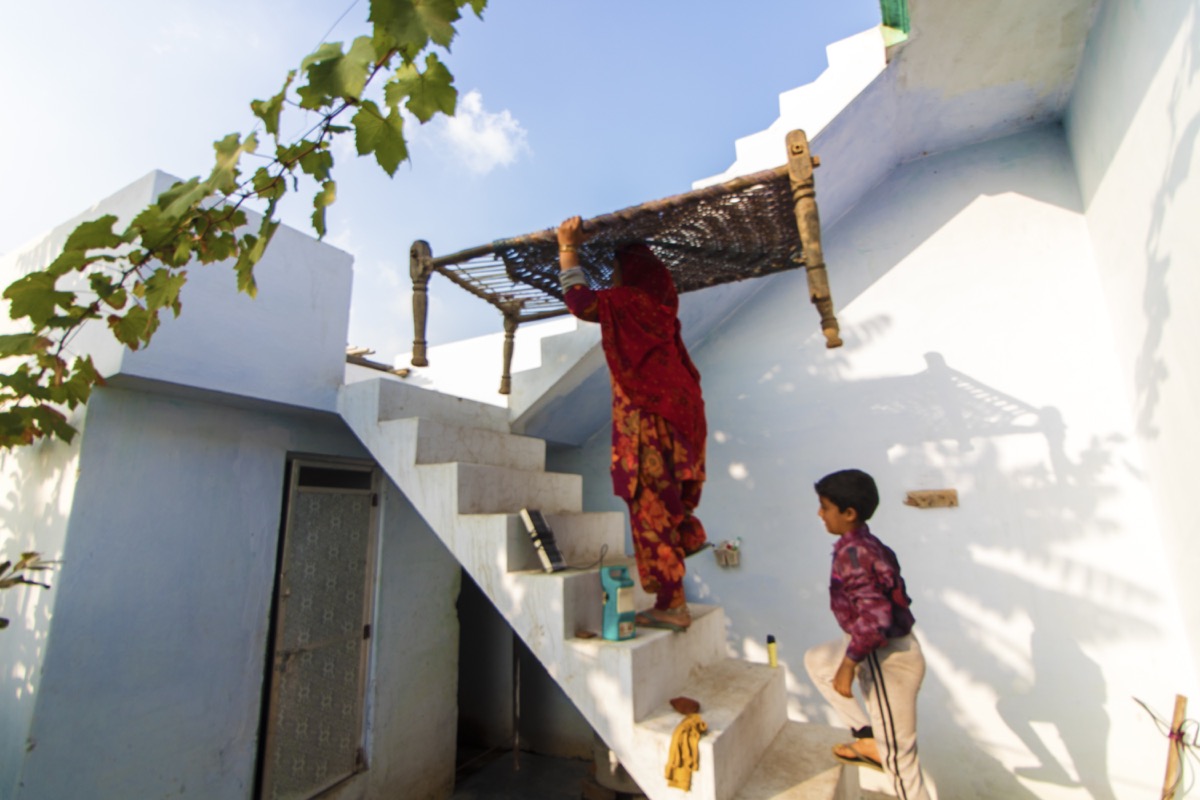
The bright lights adorn the parapets of the houses in the newly built colony in village Kandhla in western Uttar Pradesh. All the houses have been freshly painted in bright colours, decorated with streamers and paper plates, to mark the formal inauguration of the new lives of their inhabitants. The youngsters are playing the latest Bollywood songs, women are wearing their best silk, children are running in the streets with their wooden toys and men are offering sweets to the guests who have come to see the inauguration. They are now ready to leave behind the painful memories of the communal riots that changed the subsequent course of their lives. The wounds have been plastered, painted and concealed, but they peep out of the window of nostalgia now and then. Vaheed Chacha makes the trip down memory lane as he welcomes people inside his house. “There was a huge Banyan tree in Hassanpur, my village, where many generations grew up. We would go there at 10 in the morning along with our khaats (cot) to spend the entire day there. The Banyan was big enough to provide shade to a 100 cots.” The tree was central to him and others in Hassanpur, which held the community together under it’s sprawling branches. However, the tree no longer exists, just like Vaheed’s broken ties with Hassanpur.
Vaheed chacha is one of 50,000 people who was displaced after the com-munal riots between Hindu Jats and Muslims in Muzaffarnagar district of Uttar Pradesh, in August-September 2013. The violence, claimed 62 Muslim lives, and forced the rest from these ten villages, never to return.
Communal clashes in India, between the two religious communities, have been happening since 1947, when independent India came into being. About 40 such rioting incidents have taken place in the last 65 years killing more than 1.5 lakh Indian citizens. After the Muzaffarnagar riots, the state government of Uttar Pradesh, in an unprecedented move, announced a compensation of rupees five lakhs for the Muslim families of the 10 worst affected villages. For many months, the displaced families lived in refugee camps.
Sadbhavna Trust invited Hunnarshala to visit the refugee camps and meet the Internally Displaced Persons (IDPs). The families used the compensation to buy land. They were now in the process of buying tarpaulin and tents to make temporary shelters on the land. Most communities were dispersed and dismembered, acquiring land within 100 square kilometres radius of their original villages. However, sixty families from Hassanpur decided to stay together and bought some 100 plots in Kandhla. Similarly, thirty families from Kutba village also bought land collectively in Kairana village, which is 50 kilometres from their native village. These families did not have the money to build as half the compensation was used to buy land and the remaining was to be used to reestablish their business. We suggested to the community that we would help raise half the funds required to build, if they agreed to put in the remaining. We also offered to provide technical and design facilitation and help the community integrate into their new neighbourhood, with school admissions and identity papers. The families agreed to this arrangement.
Going Back to Build Ahead
Three years earlier, we requested if they would take us back to their homes in the abandoned villages. It had only been five months since they ed their villages and people were still scared to return, especially as the police had arrested many of the Hindu perpetrators. Nawab, a master mason who was one of the house owners in Kairana, took us to his village, Kutba. Nawab was de ant about going back. Perhaps it was his higher caste or his father’s good reputation that made it relatively easier for him to return. The Jats met us with curiosity in the streets. The young Jat men made caustic jokes with Nawab and finally left us to visit the abandoned homes.
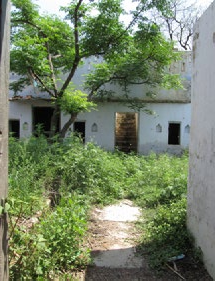
They were massive, ornate buildings, lying empty and looking like rusty parodies of their former selves. The vandalised homes still had the fragrance of burn. The old homes had huge Aangan (courtyards), which were now neglected and overgrown. There were many Kothas (rooms) with high shallow dome roofs made in exotic designs with a flower in the centre. Nawab explained with enthusiasm, going over every detail of their lifestyle and design. There was a huge gate at the entrance, with a smaller gate within, for everyday use. The Baithak in the front had its own entrance and it was largely for the male guests, as the women of the house worked in the Aangan and Baramda (Verandah). One could tell that many families lived together in the house, with many Kothas, which were occupied by the parents and the children’s families. The Chabutras (rooms on the first fioor) were reserved for the grandchildren.
The design was like an organism, which grew, changed and was nurtured by its inhabitants. It expands as the family grows; when a son is married, a new room is added for him and his new bride. Standing in the abandoned Aangan, listening to Nawab’s animated voice, we realised they did not just leave a building of bricks and mortar, but a history of several generations and many more to come.
Khaat and Chulha: The New Standards
Khaat or a cot is an integral part of their lifestyle. In one discussion, Rahisa, a woman in her late sixties insisted on having a baramda wide enough to t the Khaat lengthwise. As the discussion progressed, she vehemently opposed the idea of having a doglegged staircase, as it would be dif cult for them to carry a Khaat up to the rst oor. She was ready to settle on either a straight ight or only a 90-degree turn. Thus the Khaat became our standard of designing spaces in the new houses.
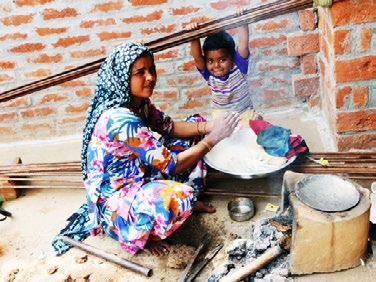
On one of our visit to Rahisa’s house while it was under construction, Shehzad, offered the plastic chair, showing respect. When we insisted on using the Khaat, as the plastic was uncomfortable in
the sweltering heat, he took some time to agree and then said, “In any case, a person can be quite lonely on a chair, on a Khaat there is togetherness!” Khaats are very versatile and multifunctional. Being lightweight, they can be moved easily from rooms to the Baramda to the terrace. On weddings and other important occasions, all the Khaats are transported to the venue for the guests.
The Chulha is another integral part of the traditional house. The concept of an assembled kitchen is very new and sometimes aspirational. The functions of the kitchen here are dispersed throughout the entire house. The utensils are arranged beautifully in the Kothas, rewood is stored on the terrace, and the Chulahs are put in the aangan. The Chulha is usually in the part of the Aangan where there is enough ventilation for the smoke to escape but no breeze to disturb the cooking. For this purpose, many families use moving Chulhas, which move with the shadows in the summers, and with the sunlight in the winters. However, the relocation from villages to a semi-urban situation wanted both, a xed platform with the moving chulah.
New Plans
The families of Hassanpur received one compensation per joint family, while in Kutba, every married family received separate compensation from the government. The sixty families of Hassanpur purchased a hundred plots in semi-urban Kandhla, and twenty Kutba families purchased 32 plots in Kairana. The relocation and rehabilitation was painful. However, it was also an opportunity for the families to rethink the idea of their houses and settlements. People were living in joint families in the villages, in social and physical structures which were not changed or challenged for generations. Every family now wanted to resurrect their lives around not just traditional family values but individual spirit and aspirations too. To infuse the traditional values with the modern aspirations, the design required a variety of arrangements to be negotiated between the joint and the nuclear-family. Most of the families wanted to live together, but with the possibility of subdividing the plot and home, if required in the future.
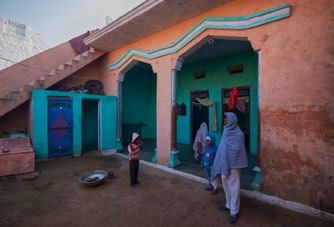
Rahisa and her three sons, Shehzad, Kallu and Zahir bought three plots together. They share the Aangan and Baramda and sometimes even their Chulhas, though they have separate kitchens and bathrooms. The youngest son Zahir who will have the option later to separate the house by making a wall in the middle of the Aangan would inherit Rahisa’s house.
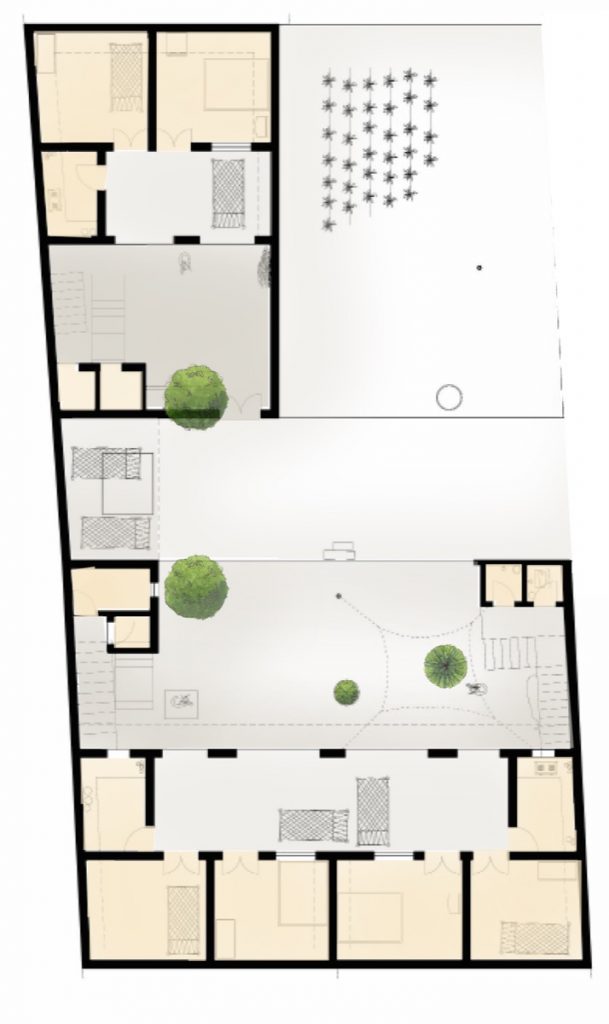
Allah Meher on the other hand opted for making a house with six rooms in an L-shaped arrangement. The house is made for the entire family to share the common Aangan and Baramda. He wants his entire family to stay together.
Naushad and his three brothers, Ehsaan, Rahisu, Shahzad built completely separate houses. He had a lot of ideas about the design and aesthetic of his house, and hardly took any of the architectural inputs from our team.
“As architects, designers and supervisors who were facilitating the process of rehabilitation and relocation of the riots affected families, it was very important for us to strike a relationship with the people who were grappling with the mistrust, suspicion and loss of faith. Most of them had the capacity to build for themselves, what they didn’t have, was the trust in their own capacities. Our work was to support the people build back the trust, brick by brick, as they rebuild their houses”
Every house was designed singularly, giving rise to about twelve different typologies ranging from the joint to the insular family, articulated in a range of plot sizes.
Brick by Brick
Bricks in the Gangetic plains compare with the best in the world. With modern kilns that provide uniform, high heat, the Avval (1st grade) brick has a strength of 150- 175kg/cm2, three to four times the average found in the country. Though historically these bricks were used with great prowess, today the buildings hardly have any foundation (6″ to a foot), with mud mortar in the walls, and no connection with the roof. At the foot of the Himalayas these are earthquake prone areas, and such buildings will collapse very quickly.
Besides proper well entrenched foundations, we introduced two innovations for the walls and roof. Rat trap bonds for the walls reduced the requirements for bricks by 25%, simultaneously improving insulation. The roofing traditions of the region were fascinating; they used six different types of at roofs! Brick and joist, plank and joist, Reinforced Brick Concrete (RBC), RCC, jack arches and a unique cloister or shallow dome. We worked with the special artisans of plank & joist and shallow domes to make them safe and well connected to the rat trap walls.
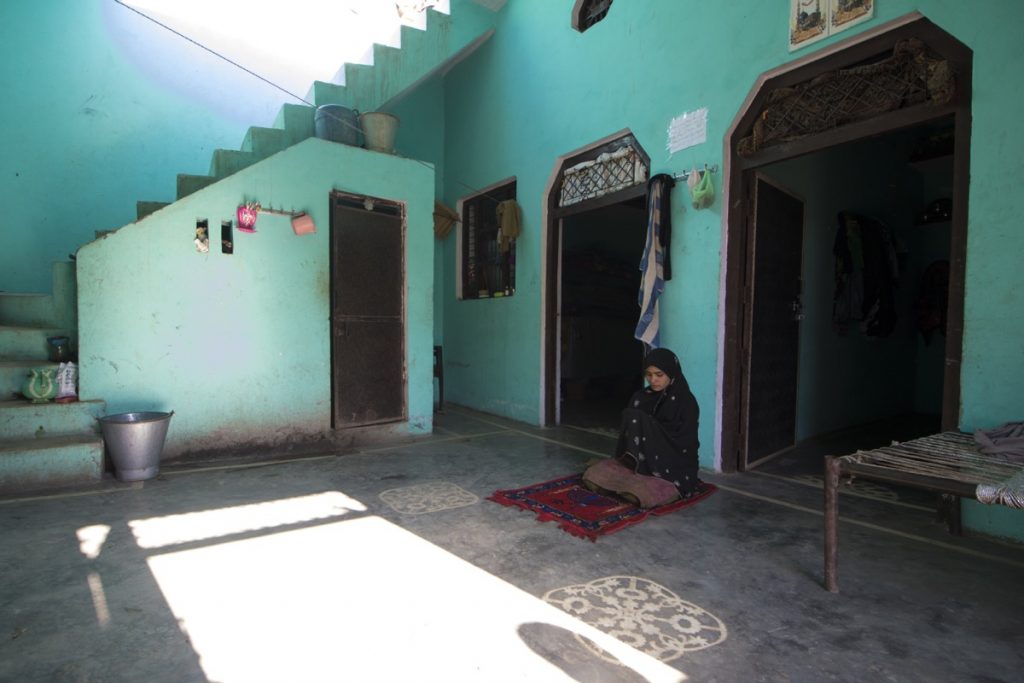
The artisans who make shallow domes continued to work with us to research, develop standards and market this amazing technology. The communities built their own homes, negotiating with markets and labouring on the site of their homes together. Besides the homes, they also built their infrastructure, including roads, sanitation and water connections.
“Three years later, Vaheed Chacha took us back to the pond; the entire village was here to greet us; the women peeling vegetables in a cohort, children climbing the trees to pull down ripe jamuns, old men taking turns to smoke hookah, others gambling or sleeping. The mood was upbeat, they had nally found a home, a village, and hopefully their faith in humanity will restore with time.”
Our first meeting in Kandhal, took place under two large jamun trees, on the banks of a pond. The enthusiasm was as tepid as the empty plots in front of us. Under the shade of the jamun trees, we sowed the first seeds of hope. Today, three years later, Waheed Chacha took us back to the pond; the entire village was here to greet us; the women peeling vegetables in a cohort, children climbing the trees to pull down ripe jamuns, old men taking turns to smoke hookah, others gambling or sleeping. The mood was upbeat, they had finally found a home, a village, and hopefully their faith in humanity.

